Configure Standalone Apps on Apple Devices
Once you have downloaded and installed a Standalone App, whether an enterprise or store version, you may need to configure the app to point to your App Server, depending upon whether or not whoever created the app supplied the App Server machine's address when creating it. If the server address changes, you can use the same method described below to edit the address to point to the new server, providing that the server address settings weren’t locked when the Standalone App was created. If any of the configuration settings have been locked, to prevent users changing them, the Standalone App will need to be rebuilt in order to make changes to those locked settings.
The Client needs to communicate with the App Server in order to authenticate that the user or device has been granted permission to run each individual Digitise app and to be able to upload and download data.
To configure a Standalone App to connect to your App Server:
-
Load the Standalone App by tapping on its icon on the device’s Home Screen.
-
You may now get a message displayed headed Untrusted Enterprise Developer, saying that your organisation has not been trusted on this device.
Make a note of the organisation’s name and then tap Cancel.
-
From the device’s Home screen, tap on Settings → General → Device Management.
Tap on the organisation named in the message displayed earlier and then on Trust “<organisationname>”.
Tap on Trust to allow apps from this organisation to run on this device or Cancel to prevent apps from this organisation running.
Tap Back → General → Settings in the top left-hand corner of the window to return to the Settings main page. Press the device’s Home key to return to the Home page.
-
Locate and tap the Standalone App’s icon again. The app will load.
-
At this point you may be asked to give your consent to the app using notifications. If you are happy to allow notifications, tap OK, otherwise tap Don’t Allow.
-
If, when the app was created, it was configured to require the user to log in, the following login fields will be displayed on the Home screen:
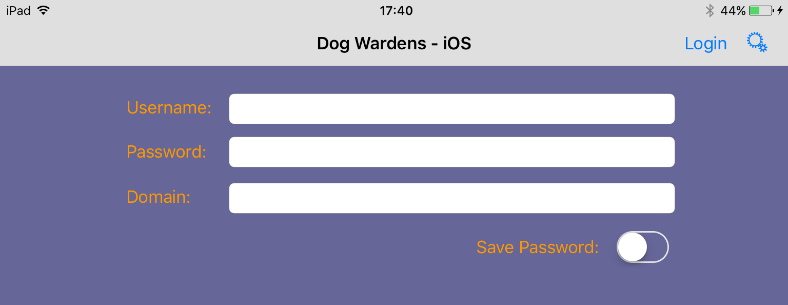
You don’t need to log in at this point.
If the app is not configured to require authentication, the app will load and automatically display the first form. Tap
 in the top left-hand corner of the screen to return to the app’s home screen.
in the top left-hand corner of the screen to return to the app’s home screen.-
Note: If your Standalone App contains more than one Digitise app, instead of directly loading an app, you will get a list of apps available within the Standalone App and the user can run the apps from this list. Once the Standalone App has been configured, whether you have to do this manually or it comes pre-configured, when you load the app you will be asked to log in. For now, tap Cancel in the top right-hand corner to dismiss the login screen.
-
-
Tap on the Settings icon in the top right-hand corner of the screen:
 .
. -
The Settings screen will be displayed:
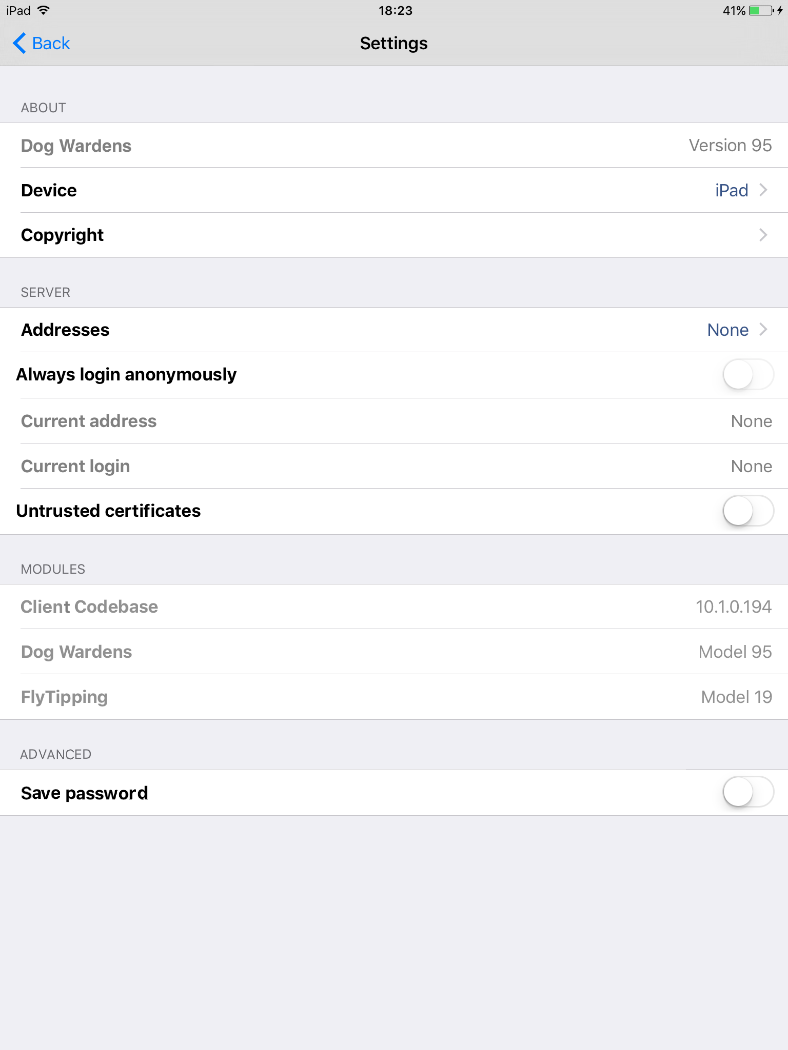
-
If this Standalone App hasn’t been supplied with the App Server address pre-configured, you will need to enter the required connection details to allow it to communicate with its App Server.
To view or edit the App Server connection details, tap Addresses under the Server section.
-
The developer can configure and lock settings when the Standalone App is created. Settings which have been locked can be viewed but not edited. This applies to the Server Address settings and to the other configuration settings described below.
-
-
The Servers screen will be displayed:
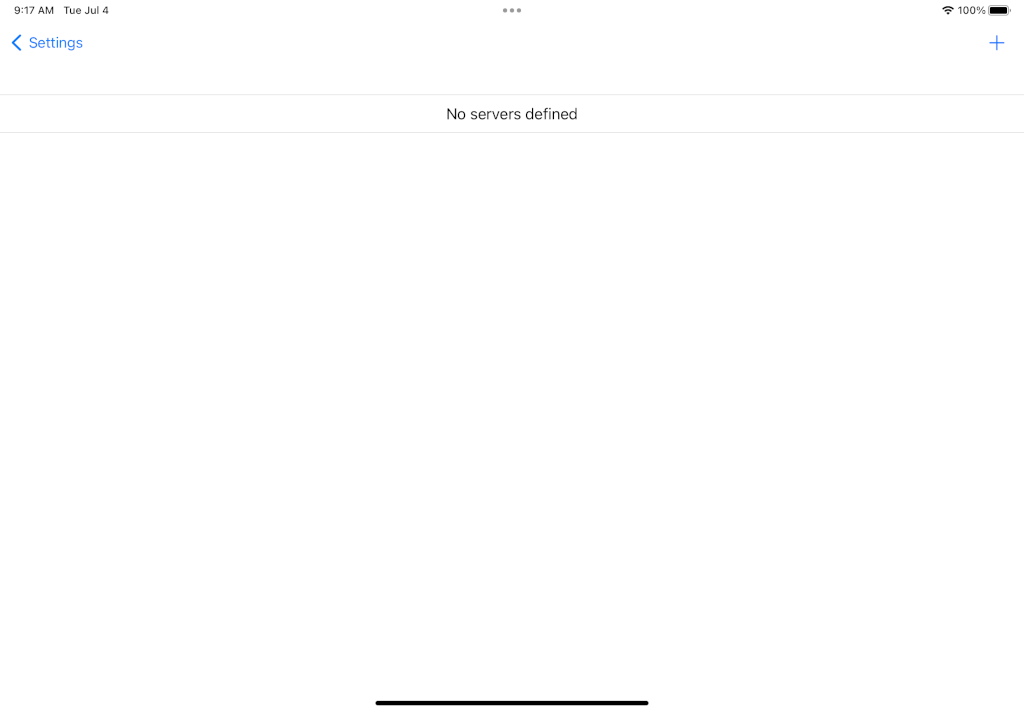
-
Tap the Add button,
 , to add a new App Server:
, to add a new App Server: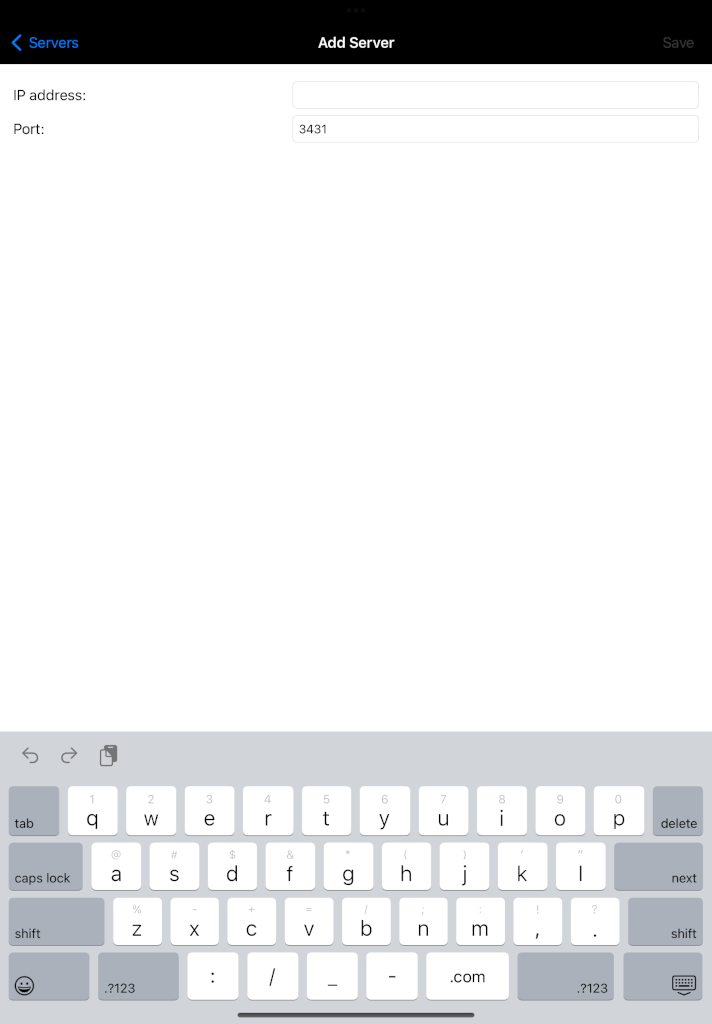
-
Enter the DNS name or IP address of the Server running your App Server in the IP address field.
-
If you will be using the enhanced certificate-based private key exchange encryption mechanism for data in transit between your App Server and Digitise Apps Client, and you enter a DNS name here, the DNS name you enter must match one of the hostnames specified in your SSL Certificate’s Common Name field and/or Alternative Names fields.
Leave the Port at its default setting of 3431, unless you are sure that port is in use by another application. Note that if you do change it here, you also need to change it on the App Server, which you do using App Manager - the Port setting can be found within the Server category Properties.
-
-
Tap the Save button,
 , to return to the Servers screen. Your newly entered details will now be displayed:
, to return to the Servers screen. Your newly entered details will now be displayed:
-
You can enter more than one server in this list if required, for example to provide access to a backup server, and when the Client attempts to connect to the App Server, if the first address in the list fails it will automatically try the next one down and so on. On subsequent connections within the same session, the last used successful address will automatically be tried first. A session ends when you close down the Client/Standalone App or modify the server list.
To add another address, tap the Add button,
 , again.
, again.If you enter multiple Servers, they will be displayed on the Servers screen like this:
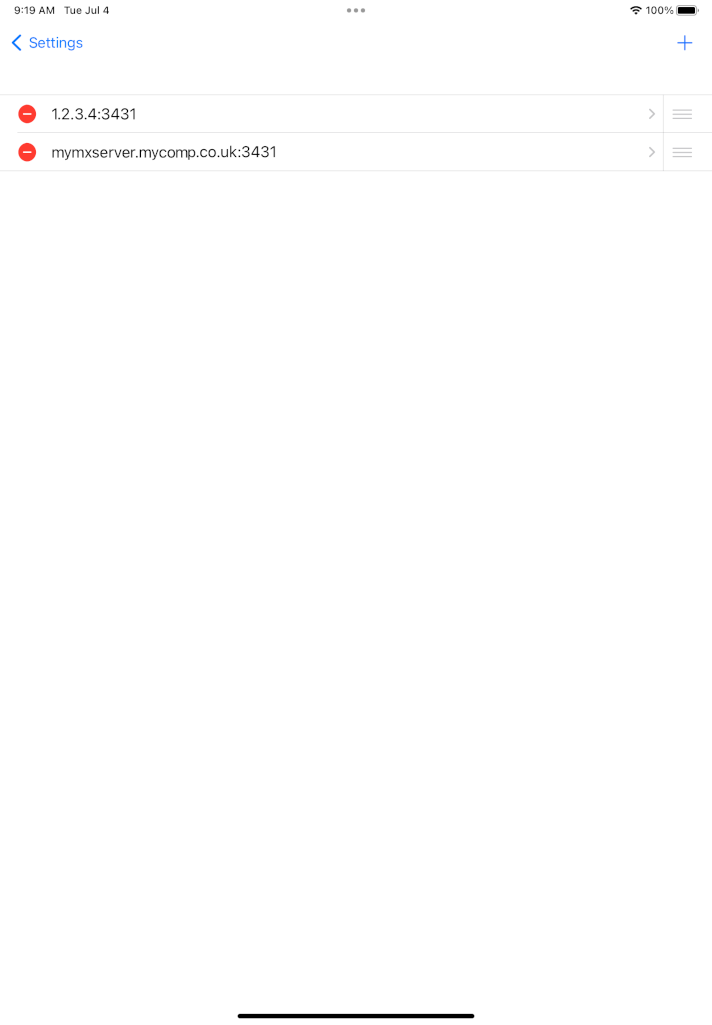
To edit an entry in the Servers list, tap the > at the end of the row.
To delete an entry, tap
 and then tap
and then tap  .
.To change the order in which the Servers are listed, and hence tried, tap and hold
 at the end of the row and then drag the row to the position you want it be within the list and release it.
at the end of the row and then drag the row to the position you want it be within the list and release it. -
When you have finished, tap
 to return to the Settings screen, which provides access to the Standalone App configuration options and system information.
to return to the Settings screen, which provides access to the Standalone App configuration options and system information.This screen contains the following items:
 ABOUT section
ABOUT section
<appname>
Displays the Standalone App version number.
Device
Displays the type of device in use. Tap on > to display more information about the device, including the current operating system version, screen size, IP Address and the expiry date of the Provisioning Profile used to code sign the Client.
Copyright
Tap on > to display various copyright messages.
 SERVER section
SERVER section
Addresses
Add a new App Server address and view currently configured server list.
Always login anonymously
If set to ON, this option automatically logs into the App Server as an anonymous user when you load this app. If set to OFF, you will be prompted to enter your login credentials, if required, when the app is loaded. Login is required if you have set access permissions for any of your Digitise apps in the App Manager utility.
By default, this option is set to OFF.
Current address
Displays the last App Server the device connected to. If this is not the first server in the Servers list, the next time you attempt to connect to an App Server within this session, the Client will try the address displayed here before trying the other servers in the list. A session ends when you close down the Client or modify the list of Server addresses.
Current login
Displays the username of the currently logged in user.
Untrusted certificates
This option is only relevant if you are using the enhanced certificate-based private key exchange encryption mechanism for data transferred between the App Server and the Standalone App and you are using an SSL Certificate which doesn’t have a trusted third-party Root Certificate, e.g. if you are using a self-signed Certificate.
By default, the option is set to OFF, which means the device must have an appropriate trusted Root Certificate installed in order for the Client to communicate with the App Server. If you are using a self-signed Certificate or the Client or Standalone App displays a message saying that the Certificate is untrusted, you can set this option to ON in order to use your chosen Certificate.
 MODULES section
MODULES section
This section displays versions numbers for the Digitise Apps Client and the Models contained within this Standalone App.
 ADVANCED section
ADVANCED section
Save password
Determines whether the Standalone App will save the user’s password, so they don’t have to enter it in the login screen each time they login. The app won’t login automatically but will pre-populate the password field within the login dialog.
If selected, the password will be saved.
If not selected, only the Username and Domain fields will be remembered.
Remembered values are stored in an encrypted database on the device.
Note that this Setting is equivalent to the Save Password option which appears on the login screen. Changing the option here will automatically change the setting on the login screen and vice versa.
If you are using Google OAuth to login, this option works slightly differently – for details see Log In Using Google OAuth Authentication.
When you have finished on the Settings screen, tap
 .
. -
If you now want to run the app and your Standalone App has been configured to require authentication or you are running a Standalone App which contains more than one app, you will need to log in at this point.
The login determines whether or not you have been granted permission to use the apps contained within the Standalone App.
If the login dialog is no longer displayed, tap the Login icon,
 , in the bottom right-hand corner of the screen.
, in the bottom right-hand corner of the screen.You will need to obtain the login credentials from whoever configured the App Server, if that wasn’t you, and enter them in the login screen. There are four types of possible user - a Digitise Apps User, a Windows Domain User, a Google OAuth User or an Anonymous User.
By default, values you enter in the Username and Domain fields are automatically saved and will be filled in the next time the Login screen is displayed. When building a Standalone App, you can turn off username saving within the build request options, if required.
If the Save Password option is displayed, you can instruct the app to remember your password as well and automatically fill in the password field the next time you log in. Select the Save Password option to save your password. The password entered will be stored in an encrypted database on the device.
The Domain and Save Password options can be pre-configured and can also be locked so that the user cannot change them on the device. If the domain field is locked, you cannot include the domain in the Username field and an attempt to do so will result in an error message being displayed. If the Save Password option is set to not allow password saving and is locked, the option will not be displayed in the login screen.
If you have been given a domain name to use as part of your login, you can enter the domain name in the Domain field or include it with your username in the Username field in the format:
<domainname>\<username>
Including the domain name in the Username field will overwrite any domain name specified in the Domain field. If you do not have a domain name to enter, but there is a value in the Domain field, you will need to delete this. If you cannot clear the field, this means that the app has been configured to require a Windows domain login. If the domain field is missing, this means that the developers have removed it because it isn’t required for you to login.
-
If you are running a Standalone App which contains more than one app, there will be a third option which allows you to log in anonymously. You should only log in anonymously if your Digitise Apps Administrator tells you to do so, as anonymous users only have access to apps which do not have access permissions set. To log in anonymously, simply select the Anonymous option and tap Done.
If you log in anonymously after logging in as a Digitise Apps User or Domain User, the next time the Login screen displays, the username and password fields will be blank and the Save Password option, if displayed, will be unselected.
When you have entered your credentials, tap
 in the top right-hand corner of the screen.
in the top right-hand corner of the screen.If you need to log in as an OAuth User rather than using Digitise Apps credentials or Windows Active Directory Authentication, the Client will load a browser and present you with the Google login page instead of the login fields shown above. For more details about logging in using OAuth see Log In Using Google OAuth Authentication.
If you have entered valid credentials, the app will load and display the first form.
-